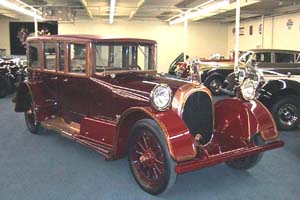1900 – Delco invents the first electrical distributor for automobile engines.
1901 – Olds begins production of the famous Oldsmobile Curved Dash runabout. Speedometers used for the first time. Ettore Bugatti designed his first car.
1902 – Henry Leland replaces Henry Ford as chief engineer at the Detroit Automobile Company, which is renamed the Cadillac Automobile Co.
1903 – Bathtub maker David Dunbar Buick starts a Buick plant in Flint, Michigan, and sells it to William Durant the next year. Glass windshields are used on autos for the first time. First cross country trip by automobile. Henry Ford founds the company bearing his name.
1904 – Studebaker introduces a gasoline auto. Cadillac is among the first to use a steering wheel instead of a tiller. First production Maxwells roll off the line in NY. Rolls-Royce Limited founded by Charles Stewart Rolls and Henry Royce in Britain.
1905 – First transcontinental auto race sponsored by Oldsmobile.
Cars could be purchased on an installment plan.
1906 – Ford uses vanadium on the Model N-a heat-treated steel that is lighter and stronger than conventional steel.
1907 – A four-cylinder engine with sliding transmission introduced by Buick.
1908 – Steering wheels moved to the left-hand side on most autos. First grooved automobile tire appears. Buick owner William C. Durant forms General Motors. Ford Model T goes on sale for $850: with 20 horsepower, top speed of 45 mph, & 30 mpg. It sold 10,600 units the first year.
1909 – Automobile storage battery invented by Thomas A. Edison.











 The Corsair, based on a Cord automobile chassis, was more an out-right failure of styling than of design. The Cord Company had been responsible for some very good-looking automobiles. This was party because Cord chassis, with their high-performance engines and exotic front-wheel-drive configuration, were naturals for any designer with a yen for sleekness and and exclusivity. Among the designers Cord cooperated with were Gordon Buehrig and Carl Van Ranst, who turned out notable designs for the L-29, the 810 and 812 Berline.
The Corsair, based on a Cord automobile chassis, was more an out-right failure of styling than of design. The Cord Company had been responsible for some very good-looking automobiles. This was party because Cord chassis, with their high-performance engines and exotic front-wheel-drive configuration, were naturals for any designer with a yen for sleekness and and exclusivity. Among the designers Cord cooperated with were Gordon Buehrig and Carl Van Ranst, who turned out notable designs for the L-29, the 810 and 812 Berline.
